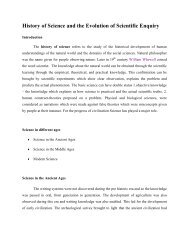Papermaking Where There is No Papermaking Tradition - (CUSAT ...
Papermaking Where There is No Papermaking Tradition - (CUSAT ...
Papermaking Where There is No Papermaking Tradition - (CUSAT ...
You also want an ePaper? Increase the reach of your titles
YUMPU automatically turns print PDFs into web optimized ePapers that Google loves.
Bindhu collects pineapple leaves for papermaking fiber.<br />
An ikat weaver at Pochampalli in Andra Pradesh, central India. <strong>No</strong>te the white<br />
marks around the terracotta pit where he sits at h<strong>is</strong> loom. These marks indicate<br />
cloth and thread’s sacred place in Indian culture, a status rarely granted paper.<br />
cooking and hand beating fiber laborious and time-consuming.<br />
<strong>Papermaking</strong> at the Rural Centre was a low priority compared<br />
to almost everything else. The women worked at SEWA because<br />
they needed a job, not out of interest in handmade paper and local<br />
fibers. They had not seen other handmade papers so they had<br />
nothing to compare theirs to. Despite the center’s commitment to<br />
sustainability, the women sloshed water wildly as they rinsed the<br />
cooked fiber. They were res<strong>is</strong>tant to even the most rudimentary<br />
system of measuring alkali, preferring to dump in lye in great random<br />
quantities. I carried pH strips in my pocket, testing the cook<br />
water and the rinsed fiber over and over. Gradually, they took an<br />
interest in a simple measuring system and obtaining pH papers.<br />
After we had made several batches of paper, I led them through<br />
the same exerc<strong>is</strong>e I had done with Namb<strong>is</strong>an’s PhD students—<br />
rumpling, crumpling, folding, tearing, and burn<strong>is</strong>hing a variety<br />
of papers. I introduced the idea of evaluating their paper in terms<br />
of how well it fulfilled the requirements of its intended use. Staff<br />
began asking questions and proposing experiments of their own.<br />
We talked about designing cards that reflected cultural traditions<br />
of Kerala. The women became conscious of not wasting fiber that<br />
had taken so long to prepare. I helped them to make journals with<br />
samples of the papers we had made and notes on our processes,<br />
a reference for them, though they did it mostly to humor me. We<br />
pers<strong>is</strong>ted. On the road up to the Rural Centre a military camp d<strong>is</strong>plays<br />
a large billboard: BASH ON REGARDLESS. I laughed the<br />
first time I saw it, then took it as my motto.<br />
I left the women on their own for a few days to take a short<br />
vacation north of Kerala. Before I left, I assigned some papermaking<br />
experiments. On my return, the staff proudly showed me their<br />
work. Unfortunately, during my final week, they received a large<br />
order for blank conference books made with their usual paper, so<br />
we could not pursue the new papers further. I left unsure whether<br />
they would continue the work we had begun. Six months later, I<br />
was thrilled to receive a stack of large sheets of the new papers that<br />
they had made after I left.<br />
Beyond refining South India’s handmade paper, the next challenge<br />
<strong>is</strong> market creation. In centuries past, India’s royal families<br />
were wealthy and d<strong>is</strong>criminating patrons of the regions’ finest<br />
crafts. With the end of royal states, some traditions have died for<br />
want of patronage. Deep appreciation of the remaining arts <strong>is</strong> now<br />
in the hands of a tiny group of art<strong>is</strong>ts, curators, and collectors who<br />
know and appreciate fine crafts, but generally lack the wealth to<br />
keep them going. SEWA’s unfamiliarity with the possibilities of<br />
handmade paper <strong>is</strong> parallel to that of most Indians today. For years,<br />
India’s best contemporary handmade paper has been made in two<br />
centers: the Sri Aurobindo Ashram’s paper mill in Pondicherry,<br />
south of Chennai (formerly Madras); and in Sanganer, an old papermaking<br />
village in Rajasthan. I have heard that some traditional<br />
paper <strong>is</strong> still being made in Sanganer. Apart from that possibility, I<br />
am unaware of any Indian papermakers using traditional materials<br />
or technology, or making burn<strong>is</strong>hed plant papers for miniature<br />
painting, though there would be some market for it. Today’s miniature<br />
art<strong>is</strong>ts paint on the backs of fine old papers, or not so fine,<br />
somewhat old papers. The paintings are skillful, often beautiful,<br />
and merit a reliable source of paper.<br />
In South India’s larger cities and tour<strong>is</strong>t hubs, department<br />
stores and a few specialty shops sell endless varieties of neon-colored,<br />
machine-embroidered, flocked, sequined, and splattered papers<br />
labeled “handmade.” These papers lack entirely the integrity<br />
of material that <strong>is</strong> a hallmark of fine paper. <strong>There</strong> are a tiny number<br />
of shops selling real handmade paper.<br />
How to increase the domestic market for true handmade paper<br />
<strong>is</strong> a challenge. A more elit<strong>is</strong>t approach might include: educating<br />
art<strong>is</strong>ts and upwardly mobile Indians in the aesthetic of fine<br />
winter 2010 • 37














